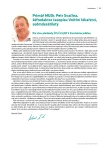“Stressful holiday” – takotsubo cardiomyopathy
Authors:
Lumír Koc; Marie Pavlušová; Jiří Pařenica; Jan Maňoušek; Jitka Vlašínová; Jindřich Špinar; Petr Kala
Authors‘ workplace:
Interní kardiologická klinika LF MU a FN Brno, pracoviště Bohunice, přednosta prof. MUDr. Jindřich Špinar, CSc., FESC
Published in:
Vnitř Lék 2015; 61(6): 531-534
Category:
Case Reports
Overview
Takotsubo cardiomyopathy (TTC) is an acute syndrome characterized by rapid onset of transient systolic dysfunction of the left ventricle. Symptoms, ECG and laboratory findings resemble acute coronary syndrome, from which TTC differs by the absence of coronary artery disease. In typical cases, TTC is triggered by exposure to unexpected stress and the clinical course and prognosis are very good. We present a case of a 63-year-old woman, in whom the onset of the disease was complicated by ventricular fibrillation. The patient recovered without sequelae thanks to immediate cardiopulmonary resuscitation and following care in a specialized cardiocenter, which involved also implantation of implantable cardioverter defibrillator to prevent sudden cardiac death. Takotsubo cardiomyopathy is an important entity in the differential diagnosis of acute coronary syndrome. Despite very good prognosis in most cases it should not be underestimated and it deserves careful attention and treatment which can prevent harmful complications.
Key words:
myocardial infarction – sudden cardiac death – takotsubo cardiomyopathy – ventricular fibrillation
Sources
1. Akashi YJ., Goldsterin DS, Barbaro G et al. Takotsubo cardiomyopathy: a new form of acute, reversible heart failure. Circulation 2008; 118(25): 2754–2762.
2. Bybee KA, Prasad A. Stress-related cardiomyopathy syndromes. Circulation 2008; 118(4): 397–409.
3. Prasad A, Lerman A, Rihal CS. Apical ballooning syndrome (Tako-Tsubo or stress cardiomyopathy): a mimic of acute myocardial infarction. American Heart Journal 2008; 155(3): 408–417.
4. Kurisu S, Kihara Y. Tako-tsubo cardiomyopathy: clinical presentation and underlying mechanism. J Cardiol 2012; 60(6): 429–437.
5. Aschermann M, Aschermann O. Tako-tsubo cardiomyopathy. Vnitr̆ Lék 2009; 55(9): 792–796.
6. Akashi YJ, Tejima T, Sakurada H et al. Left ventricular rupture associated with Takotsubo cardiomyopathy. Mayo Clin Proc 2004; 79(6): 821–824.
7. Thygesen K, Alpert JS, Jaffe AS et al. Third universal definition of myocardial infarction. J Am Coll Cardiol 2012; 60(16): 1581–1598.
8. Haghi D, Fleuchter S, Suselbek T et al. Cardiovascular magnetic resonance findings in typical versus atypical forms of the acute apical ballooning syndrome (Takotsubo cardiomyopathy). Int J Cardiol 2007; 120(2): 205–211.
9. Deetjen AG, Conradi G, Möllmann S et al. Value of Gadolinium-Enhanced Magnetic Resonance Imaging in Patients with Tako-Tsubo-Like Left Ventricular Dysfunction. J Cardiovasc Magn Reson 2006; 8(2): 367–372.
10. Simonetti OP, Kim RJ, Fieno DS et al. An improved MR imaging technique for the visualization of myocardial infarction. Radiology 2001; 218(1): 215–223.
11. Mahrholdt Heiko, Goedecke Ch, Wagner A et al. Cardiovascular magnetic resonance assessment of human myocarditis: a comparison to histology and molecular pathology. Circulation 2004; 109(10): 1250–1258.
12. Ibanez B, Choi BG, Navarro F et al. Tako-tsubo syndrome: a form of spontaneous aborted myocardial infarction? Eur Heart J 2006; 27(12): 1509–1510.
13. Hoyt J, Lerman Amir, Lennon RJ et al. Left anterior descending artery length and coronary atherosclerosis in apical ballooning syndrome (Takotsubo/stress induced cardiomyopathy). Int J Cardiol 2010; 145(1): 112–115.
14. Tsuchiohashi K, Ueshima K, Uchida T et al. Transient left ventricular apical ballooning without coronary artery stenosis: a novel heart syndrome mimicking acute myocardial infarction. Angina Pectoris-Myocardial Infarction Investigations in Japan. J Am Coll Cardiol 2001; 38(1): 11–18.
15. Weihs V, Szücs D, Fellner B et al. Stress-induced cardiomyopathy (Tako-Tsubo syndrome) in Austria. Eur Heart J Acute Cardiovasc Care 2013; 2(2): 137–146.
16. Syed FF, Asirvatham SJ, Francis J. Arrhythmia occurrence with takotsubo cardiomyopathy: a literature review. Europace 2011; 13(6): 780–788.
17. Takotsubo cardiomyopathy and arrhythmic risk: the dark side of the moon. Eur Rev Med Pharmacol Sci 2013; 17 (1): 105–111. Dostupné z: <http://www.europeanreview.org/article/1234>.
18. Dib Ch, Prasad A, Friedman PA et al. Malignant Arrhythmia in Apical Ballooning Syndrome: Risk Factors and Outcomes. Indian Pacing Electrophysiol J 2008; 8(3): 182–192.
19. Elesber A, Prasad A, Lennon RJ et al. Four-Year Recurrence Rate and Prognosis of the Apical Ballooning Syndrome. J Am Coll Cardiol 2007; 50(5): 448–452.
20. Bonello L, Com O, Ait-Moktar O et al. Ventricular arrhythmias during Tako-tsubo syndrome. Int J Cardiol 2008; 128(2): e50-e53.
21. Kursiu S, Inoue I, Kawagoe T et al. Time course of electrocardiographic changes in patients with tako-tsubo syndrome: comparison with acute myocardial infarction with minimal enzymatic release. Circ J 2004; 68(1): 77–81.
Labels
Diabetology Endocrinology Internal medicineArticle was published in
Internal Medicine

2015 Issue 6
Most read in this issue
- Diagnosing and therapy of gout
- Guidelines of Czech Association for Thrombosis and Haemostasis of the Czech Medical Association of J. E. Purkyně for safety treatment with new oral anticoagulants (NOAC) – dabigatran etexilate, apixaban and rivaroxaban
- Alveolar echinococcosis – rare cystic disease of the liver – editorial
- “Stressful holiday” – takotsubo cardiomyopathy
